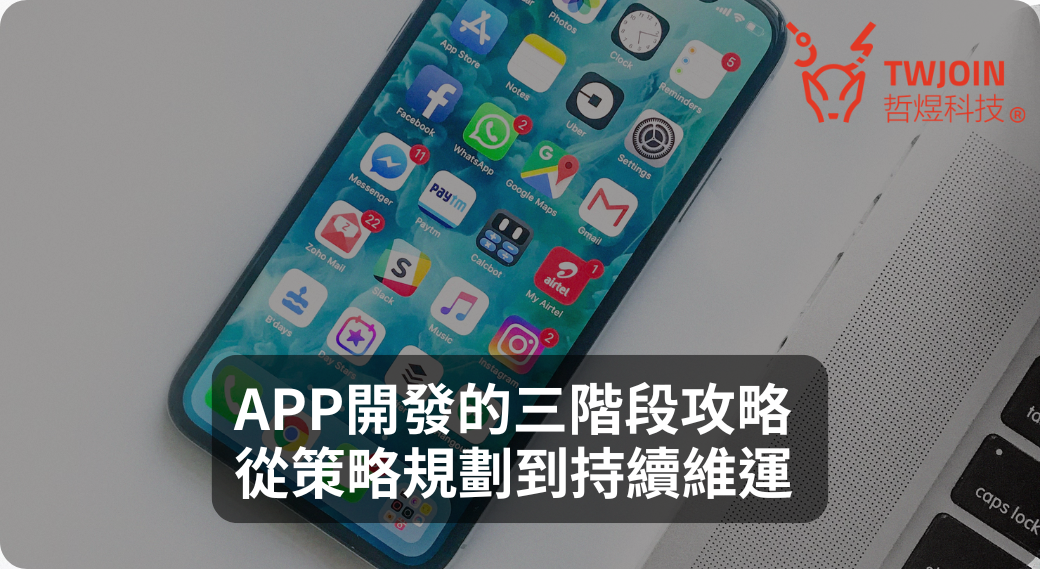2025/06/02
APP Development 3-Stage Guide:From Strategic Planning to Continuous Maintenance

Nowadays, APP development has become a key tool for brands to reach users, enhance interaction, and improve service quality. Whether you're a startup or a large enterprise, successful APP development requires a clear and solid process to reduce risks, improve efficiency, and achieve business goals. This article breaks down the "APP development process" into three core stages, sharing often overlooked yet crucial practical points and considerations to help you build a truly valuable APP development strategy.
- What is APP Development? Why Shouldn't You Only Consider the Cost?
- APP Development Three Stages: Strategic Planning, Execution, and Continuous Maintenance
- Common Pitfalls and Solutions at Each APP Development Stage
- Budget, Timeline, and Platform Selection Advice for APP Development
- How to Choose the Right APP Development Vendor?
- Conclusion: Make Your APP Not Just Exist, But Truly Used
What is APP Development? Why Shouldn't You Only Consider the Cost?
APP development refers to designing, building, testing, and launching applications that run on mobile devices (iOS, Android). Many businesses often rush to "get it done quickly" but overlook the fundamental question—why build an APP? This is the most commonly skipped thought process in APP development.
In fact, APPs are not suitable for all businesses. For some business models, platforms like Line OA or websites may be more effective. Therefore, before starting APP development, you must clearly define the purpose: Is it to enhance brand interaction? Optimize internal processes? Or support a complete core service? If the direction is wrong, no amount of money spent on development will guarantee success.
APP Development Three Stages: Strategic Planning, Execution, and Continuous Maintenance
Strategic Planning Stage: Lay the Foundation to Avoid Rework
At this stage, the most important task is not coding but answering three questions:
- What is the goal? What problem does the APP solve?
- Who will use the APP? What is the user profile?
- Compared to competitors, what are our unique features?
Common strategies include:
- Integrating online and offline services, e.g., appointments, ordering, inquiries, and notifications
- Creating member value and interaction, e.g., APP-exclusive discounts, push notifications
- Building an independent platform, e.g., medical systems, learning platforms, content media
This stage produces prototypes (Wireframe), requirement specification documents (PRD), version plans, and budget and schedule evaluations.
Execution Stage: Balancing Design and Engineering
Once the strategy is confirmed, enter the implementation phase.
- Design: UI/UX planning, design drafts (Figma), visual style, animation setup
- Frontend and backend development: iOS / Android App, API development, admin system
- System architecture: databases, cloud hosting, authentication, security design
Development is usually modularized by features and released in versions. It is recommended to use SCRUM agile methodology with weekly or bi-weekly progress checks.
Additionally, dual-platform development strategy is crucial—whether to use native development or cross-platform technologies like Flutter, React Native—which affects budget, schedule, and future maintenance.
Continuous Maintenance Stage: APP Launch is Just the Beginning
The real challenge starts after the APP launch.
- Bug fixes and updates: system errors, version updates, OS compatibility issues
- Version management and feature optimization: adjust based on user feedback, A/B testing
- Data tracking and analysis: user behavior, retention rate, conversion rate
- Marketing integration and promotion: push strategies, APP Store SEO, ad integration
Long-term success in APP development depends on continuous investment in updates and optimizations, not just one-time project delivery.
Common Pitfalls and Solutions at Each APP Development Stage
| Stage | Common Issues | Suggested Solutions |
|---|---|---|
| Strategic Plan | Lack of clear goals, market misjudgment | Write clear BRD, create Personas, analyze competitors |
| Execution | Feature creep, delayed development | Plan MVP well, control versions, lock requirements |
| Maintenance | Lack of data analysis, low usage | Establish KPI tracking, conduct regular user interviews and update planning |
Budget, Timeline, and Platform Selection Advice for APP Development
APP development costs and timelines vary greatly depending on project scale, feature complexity, and your chosen development approach.
Cost Assessment
The cost of developing an APP varies based on your feature needs.
- Basic tool APP: If your APP only provides simple tools or information, it usually requires fewer resources.
- Medium interactive platform: If your APP integrates member systems or has more interactive features, more resources are needed.
- Complex logic and automation APP: If your APP involves complex business logic, large data processing, or high automation, it requires significantly higher investment.
Timeline Planning
APP development time is dynamic and extends with project complexity.
- Early validation projects: Core function APPs developed to quickly validate ideas can be completed in shorter time.
- Full-featured projects: APPs with more complete basic functions take longer.
- Large complex platforms: Developing large, multi-functional, highly integrated APP platforms usually needs longer cycles.
Platform Selection
- If target users mainly use iOS, develop for iOS only
- For B2C products covering a broad market, dual platform is recommended
- Limited budget? Choose cross-platform technologies like Flutter or React Native
How to Choose the Right APP Development Vendor?
When selecting an APP development company, pay attention to:
- Whether they understand your business logic and pain points
- Whether they provide a complete APP development process and planning capability
- Whether they have technical documentation, version control, and testing processes
- Whether they assist with maintenance, upgrades, and optimization
- Whether they offer clear pricing and timeline
Avoid deciding solely based on the lowest quote. Software projects differ from buyout products; quality and process are inseparable.
Conclusion: Make Your APP Not Just Exist, But Truly Used
APP development is never just about coding; it connects user needs, business value, and technical implementation. Successful APP development starts with strategy, materializes technically, and ultimately continuously optimizes through maintenance and data.
If you are considering developing an APP, remember: clarify your goals first, then discuss tools and costs. This ensures your APP is not "built and forgotten," but becomes a valuable business asset.